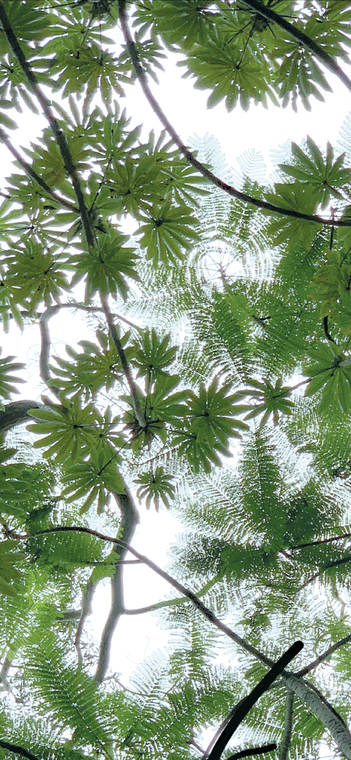Like so much of the tropical world, the rain forests of Central and South America are under assault.
There is massive timber clearing for agriculture and out of control fires, especially in the Amazon. Of course the coca crops and the war on cocaine cartels is no help. Climate change is also having an impact.
Global warming is no longer a theory and is being accepted as fact by most scientists and governments. This will affect much of the tropics, including our islands by causing more extremes such as drought, floods and severe storms.
We might not be able to do much about other parts of the world, but here at home we as individuals are either part of the solution or part of the problem.
Cutting down trees is a no-no. Planting trees is a yes-yes! That can make a big difference, since trees not only produce oxygen, they supply shade, act as windbreaks and lock up the carbon that is the main cause of global warming.
Many of Hawaii’s forests and forest watersheds are threatened, even with all the rhetoric about saving rain forests.
In East Hawaii, many forest areas are subdivided into small lots of 1-3 acres. Unless the owners of the land really commit to protecting the forested lots, they are bulldozed and flattened.
In West Hawaii, much of our uplands are still covered with native forest. Although it is sparsely populated, the gardens of places such as Kaloko Mauka are a fascinating mixture of hoawa, koa and kopiko. The area abounds with ancient ohia (Meterosideros polymorpha) and gigantic tree ferns, some of which are 30 feet or more in height. These ferns can be more than 100 years old, since the trunks only grow 2-3 inches per year.
The native forest contains many rare and endangered species that local residents are committed to protect through the county Tax Department that allows residents to dedicate their land to forest. This program allows residents to protect this important and unique watershed.
This region between 2,000 and 5,000 feet is actually cloud forest. Up to 40% of the precipitation comes from the mists that abound there. When the cloud forest is cleared, the area dries.
The cloud forest of Kaloko Mauka is the home of the Hawaiian hawk, apapane, iiwi, elepaio, amakihi and many other endemic and exotic birds.
Kaloko Mauka was identified as essential wildlife habitat and forest watershed. This is essential if our island is to have the rainfall and watershed needed to supply communities at lower elevations. It is a rare type of forest and yet is readily accessible, being only 15 minutes from Kailua-Kona.
Some folks feel that East Hawaii has plenty of rain, so forests are not necessary. However, forests are like big sponges. They slow down flooding rains and give up moisture so streams continue to run when rainfall is light.
Without forests, flooding and drought as well as severe erosion becomes the norm. Also, grasslands are infamous fire hazards during drought times.
Tropical forests of the world include not only trees but understory palms, bromeliads, orchids, ferns and bamboos. Many plants such as palms are endangered worldwide because of the destruction of rain forests. Fortunately, Hawaii is becoming a kind of Noah’s Ark thanks to the efforts of the Hawaii Island Palm Society, Bamboo Society, Sierra Club and other concerned groups.
We are here in Colombia to find species that are threatened with extinction and making sure they at least have a home in our Hawaii gardens.
Remember, not only is it vital to protect our remaining Hawaii forests, but to reforest those abandoned cane lands of Hamakua, Puna, Ka‘u and Kohala, thus ensuring valuable forest resources for future generations.
For more information about forest planting and management, contact University of Hawaii Extension Forester J.B. Friday at 959-9155.






